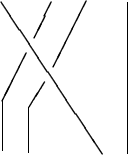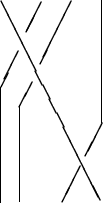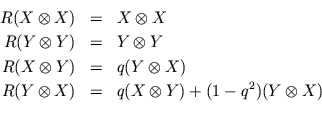I find that Polyakov model I described last time to be a great example of all sort of things: solitons, instantons, anyons, nonlinear sigma models, gauge theories, and topological quantum field theories all in one! But I want to get back to braids plain and simple and introduce the Yang-Baxter equations. I'll tone down the math for a while so that people who know only a tad of group theory can at least get the definition of the braid group.
So: braids with ![]() strands form a group, called the braid group
strands form a group, called the braid group ![]() .
(Let's take
.
(Let's take ![]() as an example.) Multiplication is just defined by
gluing one braid onto the bottom of another. For example this braid:
as an example.) Multiplication is just defined by
gluing one braid onto the bottom of another. For example this braid:

times this one:

equals this:

The identity braid is the most boring one:

I leave it as a mild exercise to show that every braid ![]() has an "inverse"
has an "inverse"
![]() such that
such that ![]() .
.
The braid group has special elements
![]() , where
, where
![]() is the braid where the
is the braid where the ![]() -th strand goes over and to the right of the
-th strand goes over and to the right of the
![]() -st. For example,
-st. For example, ![]() equals
equals

Now, the interesting thing about these "elementary braids" is that
![]() and
and ![]() commute if
commute if ![]() (check it!) but
(check it!) but ![]() and
and ![]() get
tangled up in each other. They satisfy a simple equation, however,
the Yang-Baxter equation. (This was known ages before Yang and Baxter
came along, and its importance was perhaps discovered by Artin.)
Namely,
get
tangled up in each other. They satisfy a simple equation, however,
the Yang-Baxter equation. (This was known ages before Yang and Baxter
came along, and its importance was perhaps discovered by Artin.)
Namely,
![\begin{picture}(198,179)(19,641)
\thicklines\put( 20,820){\line( 2,-3){ 72}}
\pu...
...t(120,732){\makebox(0,0)[lb]{\raisebox{0pt}[0pt][0pt]{\frtnrm =}}}
\end{picture}](img70.gif)
Draw it for yourself and check that these are topologically equivalent braids (i.e., you can get from one to the other by a little stretching and bending).
Okay, now I'll start turning the math level back up. The braid group is
obviously generated by the elementary braids ![]() , but the extremely
non-obvious fact is that the braid group is isomorphic to the group with
the
, but the extremely
non-obvious fact is that the braid group is isomorphic to the group with
the ![]() as generators and the relations
as generators and the relations
It's easy to determine the one-dimensional unitary representations of
the braid group. In such a representation each ![]() gets mapped to a
complex number of unit magnitude, which we'll just call
gets mapped to a
complex number of unit magnitude, which we'll just call ![]() . Then
the Yang-Baxter equation shows that
. Then
the Yang-Baxter equation shows that ![]() , so all the
, so all the ![]() 's are
equal. The other braid group relations are automatic. Thus for each
angle
's are
equal. The other braid group relations are automatic. Thus for each
angle ![]() there is a unitary rep of the braid group with
there is a unitary rep of the braid group with
Okay, how about reps of the braid group that are not necessarily
one-dimensional? Well, suppose ![]() is a vector space and we want to get
a rep of
is a vector space and we want to get
a rep of ![]() on the
on the ![]() -th tensor power of
-th tensor power of ![]() , which I'll call
, which I'll call ![]() . Here's
a simple way: just map the
. Here's
a simple way: just map the ![]() -th elementary braid
-th elementary braid ![]() to the linear map
taking
to the linear map
taking
Now, Baxter invented this equation when he was looking for problems in
2d statistical mechanics that were exactly solvable (i.e. one could
calculate the partition function). A simple example is the
"six-vertex" or "ice-type" model, so-called because it describes flat
square ice! (Theoretical physicists are never afraid of simplifying the
world down to the point where they can understand it.) But there are
zillions of examples -- take a look at his book on exactly solvable
statistical mechanics models! Similarly, Yang ran into the equation
while trying to cook up 2d quantum field theories for which one could
exactly calculate the S-matrix. I won't get into how this equation
does the trick right now; I just want to note that a whole industry
developed of finding solutions to the Yang-Baxter equations. This
eventually led to the discovery of quantum groups...but for now I'll
leave you with a nice solution of the Yang-Baxter equations: let ![]() be
spanned by two vectors
be
spanned by two vectors ![]() and
and ![]() , and define
, and define ![]() by
by

If you are interested in learning about quantum groups, the Yang-Baxter equations, and braids, I suggest taking a look at the following books:
L. Kauffman, Knots and Physics, World Scientific, New Jersey, 1991.
© 1992 John Baez
baez@math.removethis.ucr.andthis.edu